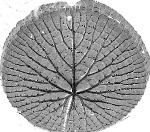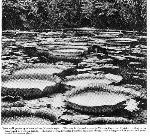
Victoria's History
By Kit Knotts - Click images to enlarge
Discovery of Victoria for the botanical world was made by Bohemian botanist and naturalist Tadeáš Haenke in 1801. Sent to Bolivia by the Spanish government to investigate the flora there, Haenke is said to have first seen Victoria on the river Mamore', one of the tributaries of the Amazon. He died in Cochabamba (today's Bolivia) without recording his discovery.
French medical doctor turned botanist Aime Bonpland, who had previously travelled
in South America with German naturalist and adventurer Alexander von Humboldt, saw Victoria
near Corrientes, Argentina, in 1819 and, in 1825, sent seeds
and a full description to France. In 1832 Eduard Poeppig found it on the Amazon and
gave the first published account of it under the name Euryale
amazonica, his supposition being that it belonged to the
same genus as the Asian Euryale ferox.
Alcide d'Orbigny saw the plant in Corrientes in 1827 and sent
specimens and drawings to France. He saw it again in Bolivia
in 1833 and published accounts of it several years later. German
botanist Robert Schomburgk found Victoria on
the Berbice River in British Guiana in 1836 and sent specimens
and figures home to Europe. It was from these, in 1837, that
English botanist and horticulturist John Lindley established the genus Victoria
and described the species regia in honor of Queen Victoria.
(2002 - Ongoing investigation raises questions as to whether
the epithet should have been regia or regina.)
Poeppig's Euryale amazonica has since been placed in the
genus Victoria and V. amazonica takes precedence
over V. regia or regina, due to prior publication.
This is the accepted name for the more tropical Amazonian species.
The less tropical species found at Corrientes was named V.
cruziana by d'Orbigny in 1840, in honor of General Santa
Cruz of Bolivia.
Schomburgk was the first to try to cultivate Victoria,
attempting to transplant it from lakes and streams to Georgetown,
British Guiana. The plants died. In 1846, Thomas Bridges sent
seeds packed in a jar of wet clay to England. Of 25 received
at Kew Garden, three germinated, grew well as seedlings until
winter when they perished. In 1848 dry seeds and rhizomes were
sent to England but the rhizomes rotted and the seeds didn't
germinate. In 1849, 35 live plants were taken to England but
they all died.

Two English physicians, Rodie and Luckie, sent seeds to Kew in
bottles of fresh water. These arrived in February of 1849. From
them, the first plant flowered November 8, 1849 in a specially
built greenhouse at the Duke of Devonshire's estate at Chatsworth.
One of these earliest flowers was cut and presented to Queen
Victoria.
 Joseph
Paxton, the Duke's chief gardener, was so inspired by the
structure of the leaf of Victoria that he incorporated
it into an architectural design for a conservatory. This design
was used in the construction of the Crystal Palace for the Great
Industrial Exhibition of 1851 in London.For this and other accomplishments,
Paxton received the honor of Knighthood.
Joseph
Paxton, the Duke's chief gardener, was so inspired by the
structure of the leaf of Victoria that he incorporated
it into an architectural design for a conservatory. This design
was used in the construction of the Crystal Palace for the Great
Industrial Exhibition of 1851 in London.For this and other accomplishments,
Paxton received the honor of Knighthood.
In the year after that the first plant flowered, two others bloomed
in England, one at Syon House and the other at the Royal Botanic
Gardens at Kew. The Victoria at Kew was under the care of James
Gurney, who would later become superintendent of Tower Grove
Park in St. Louis, Missouri. He was present when Queen Victoria,
accompanied by the French president (later Napoleon III), came
to view the first flowering.
Seeds obtained from these plants were distributed throughout
Europe, Asia and America. Eduard
Ortgies, who actually grew the first plant for Paxton, took
a seedling to his new employer, nurseryman Louis
Van Houtte in Belgium. In a glass house constructed especially
for it, the Victoria flowered in September of 1850, the first
on the Continent.
Thomas Meehan flowered the first plant in the United States
in 1851 in the garden of Caleb Cope, Springbrook, Pennsylvania.
In 1852 John F. Allen of Salem, Massachussetts, grew a plant
from Cope's seeds. This plant grew through four summers and produced
over 200 flowers.

Edward Rand sent seeds from Para, Brazil, to Edmund Sturtevant
in Bordentown, New Jersey. The resulting plants flowered in 1886
and were slightly different from those flowered before. They
were called V. regia var. Randii and were said
to have taller, wavier rims than the known form of V. regia.
They have been lost in cultivation and have not been rediscovered
in the wild.
In 1894 William Tricker received seeds from a European house
purported to be the true V. regia (correctly V. amazonica).
Some of those that germinated and grew to flowering age had light
green leaves that cupped at an early age. This different Victoria
was "distinguished provisionally as 'Tricker's variety'
" by William Tricker. Further investigation by Tricker and
Henry S. Conard revealed that the stock came from Corrientes,
Argentina, and was V. cruziana d'Orbigny.
It has been written that the form of Victoria amazonica
introduced from British Guiana had leaves that were nearly flat
until it achieved considerable size when it made a low rim. Others
have moderately low rims where V. cruziana has high rims.
The two could possibly grade together in Matta Grosso, Brazil.
Until recently, the largest Victoria that we found reported
was grown in 1891 at the United States Botanic Garden in Washington,
D.C. under the care of George W. Oliver. It measured 90 inches
in diameter and the plant had a spread of 47 feet. In 2006, the
Victorias
of La Rinconada, near Santa Cruz, Bolivia, set the world
record at 106.3" (2.70 m).
In historical references and sometimes modern-day usage, Victoria
regia and Victoria amazonica are terms used inaccurately
in place of the stand-alone genus name Victoria. This
can lead to confusion, especially among growers, viewers (and
web site builders!) when the plant is the other species or one
of the six cultivars. (See Victoria
Identification.)
References:
Bailey, L.H. The Standard Cyclopedia of Horticulture.
1914. The MacMillan Co., New York.
Bisset, Peter. The Book of Water Gardening. 1905. A.T. De La
Mare, New York.
Conard, Henry S. and Henri Hus. Water-lilies and How To Grow
Them. 1914. Doubleday, Page & Company, Garden City, New York.
Pring, George. Missouri Botanical Garden Bulletin. Vol. 37(3):85-88,
1949.
Ribero, Tonchi. The Largest Victoria Pads Ever Recorded!
Tricker, William. The Water Garden, 1897. A. T. De La Mare, New York
-------. Eduard Ortgies. Gartenflora, p. 225-229, 1894.
|
by John Fisk Allen, with illustrations by William Sharp 1854 For shorter download Page 1 | Page 2 | Plates |
||
|
|
||
|
The Gardeners' Chronicle 1850 |
Wisconsin State Horticultural Society 1885 |
Garden and Forest 1888 |
|
|
||
|
|
||
|
|
||
|
|
|
|
|
|
||
|
|
|
Articles |
|
|
|
|
|
|
|
|